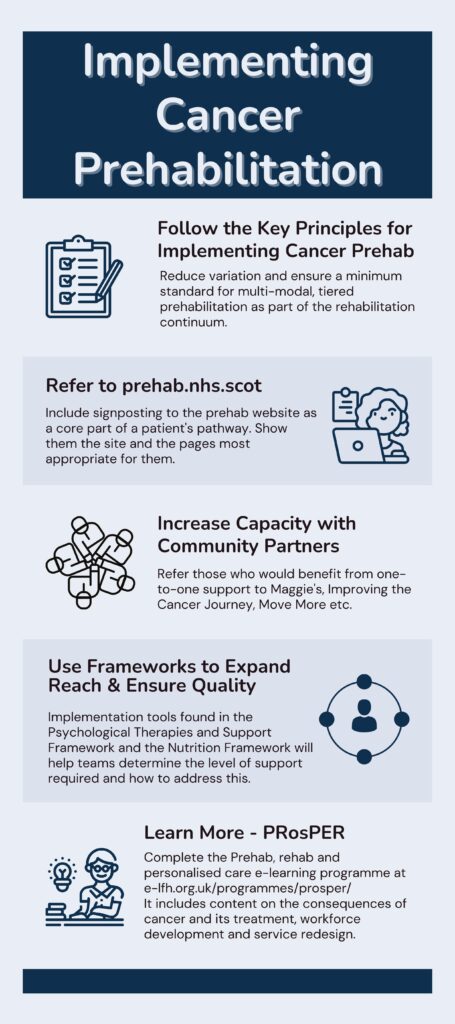Cancer Prehabilitation is defined as “a process on the cancer continuum of care that occurs between the time of cancer diagnosis and the beginning of acute treatment and includes physical and psychological assessments that establish a baseline functional level, identify impairments, and provide interventions that promote physical and psychological health to reduce the incidence and/or severity of future impairments.”
Silver et al. CA Cancer J Clin, 2013.
Evidence has shown that cancer prehabilitation can yield the following benefits;
- Better response to treatment
- Quicker recovery
- Reduced incidence and severity of treatment side effects
- Reduced risk of post-operative complications
- Reduced anxiety and improved mood
- Improved energy levels
- Patients take an active role in their cancer care
- Lower chance of cancer recurrence
- Improves general fitness and can lessen severity of other health conditions
- Improves ability for patient to fulfil normal activities of daily living
- Greater sense of empowerment over their treatment experience
As such, cancer prehabilitation, as a component of rehabilitation, should underpin the whole cancer pathway and is an approach we seek for all patients with cancer in Scotland.
___________________________________________________________________________
Implementing cancer prehabilitation
Insights form those with a lived experience of cancer
The Health and Social Care Alliance Scotland (the ALLIANCE) were commissioned by the Scottish Government and it’s Cancer Prehabilitation Implementation Steering Group to conduct a series of focus groups. The groups would inform the design and delivery of cancer prehabilitation services in Scotland. A report detailing the findings of the focus groups has been produced and it includes a series of recommendations. The Cancer Prehabilitation Implementation Steering Group (CPISG) has welcomed these recommendations and would encourage anyone who is developing a prehabilitation service to consider their role in implementing these recommendations. The CPISG has also set out how they are responding to these in a formal reply:
Cancer prehabilitation focus groups: Insights report
Cancer Prehabilitation Implementation Steering Group response to the ALLIANCE’s focus group recommendations
Reducing variation
To address unwarranted variation and ensure quality of care a series of resources have be created to support the sustained development and implementation of cancer prehabilitation across Scotland.
Resources:
- Key Principles for Implementing Cancer Prehabilitation across Scotland
- Psychological Therapies and Support Framework for People Affected by Cancer
- Nutrition Framework for People with Cancer
The image opposite explains how these resources can be used alongside this website and e-learning opportunities to improve service provision.
Scotland’s Cancer Prehabilitation Implementation Steering Group would also recommend use of Macmillan’s ‘cancer and physical activity standard evaluation framework‘ to aid evaluation of impact with respect to physical activity/exercise.
Further resources and training opportunities
Finally, the PRosPer programme which can be found under the ‘Education and Training‘ tab includes a toolkit to support service development and evaluation.

Insights from established services
From Theory to Practice: An International Approach to Establishing Prehabilitation Programmes (external link), published in Current Anesthesiology Reports in February 2022 also gives suggestions on implementation based on experiences from three countries.
